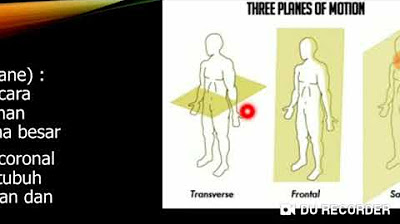Anatomical Position and Directional Terms [Anatomy MADE EASY]
Summary
TLDRThis educational video simplifies the understanding of anatomical directional terms, crucial for medical and scientific studies. It introduces the standard anatomical position and systematically explains terms like medial/lateral, superior/inferior, anterior/posterior, proximal/distal, superficial/deep, unilateral/bilateral, ipsilateral/contralateral, using mnemonic devices and practical examples. The script encourages viewers to engage with the material by watching to the end, reading captions, and referring to previous videos for more context.
Takeaways
- 📚 The video introduces anatomical directional terms, providing a standard anatomical position for reference.
- 🧍 The standard anatomical position is described as standing upright with arms at sides, palms forward, and feet parallel.
- 🔍 Right and left are defined relative to the patient, with 'R' and 'L' indicating sides.
- 🤔 The script explains the terms 'medial' and 'lateral', using the midline of the body as a reference for direction.
- 📐 'Medial' means toward the middle of the body, while 'lateral' means toward the side, with mnemonics like 'M' for medial.
- ⏫ 'Superior' and 'inferior' are terms for above and below, respectively, with 'superior' toward the head and 'inferior' toward the feet.
- 🔑 Superior and inferior can also be referred to as 'cranial' and 'caudal', with mnemonics like 'S' for skull and 'F' for floor.
- 🚶♂️ 'Anterior' and 'posterior' describe the front and back of the body, with 'anterior' being ventral and 'posterior' being dorsal.
- 🤲 'Proximal' and 'distal' are used for extremities, with 'proximal' meaning closer to the trunk and 'distal' meaning further away.
- 👆 'Superficial' and 'deep' describe positions relative to the body's surface, with 'superficial' being closer and 'deep' being further from the surface.
- 🔄 Unilateral and bilateral describe conditions affecting one or both sides of the body, respectively, with 'uni' for single and 'bi' for double.
- 🔄 Ipsilateral and contralateral indicate the same or opposite sides of the body, with 'ipsi' for same and 'contra' for opposite.
Q & A
What is the standard anatomical position and why is it important?
-The standard anatomical position is a reference position where the body stands upright with the head and eyes directed straight ahead, arms hanging at the sides, palms forward, and feet flat on the ground facing forward. It is important because it provides a consistent, universal way to discuss anatomy and creates clear reference points for anatomical terms.
What is the definition of the midline in the context of anatomy?
-The midline is an imaginary vertical line down the middle of the body that divides the body into equal right and left sections. It serves as a reference point for describing medial and lateral directional terms.
How can you remember the term 'medial' in anatomy?
-You can remember 'medial' by associating it with the letter 'M', which stands for midline, middle, and moving toward the middle of the body.
What does the term 'lateral' signify in anatomical terms?
-Lateral refers to the side or toward the side of the body, indicating movement away from the midline and toward the sides. It can be remembered by thinking of 'lats', which are the side back muscles.
What is the difference between 'superior' and 'inferior' in anatomical terms?
-'Superior' refers to above or toward the head, while 'inferior' refers to below or away from the head. They can also be remembered by their alternative names 'cranial' and 'caudal', respectively.
How can you use the terms 'anterior' and 'posterior' to describe the location of body parts?
-'Anterior' describes the front or toward the front of the body, and 'posterior' describes the back or toward the back of the body. These terms can also be remembered by their alternative names 'ventral' and 'dorsal', respectively.
What does 'proximal' mean in relation to body parts and structures?
-'Proximal' means toward the trunk or near the point of attachment or origin, indicating movement closer to the central part of the body.
How can you remember the term 'distal' in anatomical descriptions?
-You can remember 'distal' by thinking of the word 'distant', which signifies being far away from the trunk or point of attachment.
What is the difference between 'superficial' and 'deep' in anatomical terms?
-'Superficial' refers to closer to the surface of the body, while 'deep' refers to away from the surface of the body. 'Superficial' can be remembered by its association with the word 'surface'.
What do 'unilateral' and 'bilateral' mean in medical descriptions?
-'Unilateral' refers to involving one side of the body, while 'bilateral' refers to involving both sides of the body. These terms are derived from the prefixes 'uni-' meaning one, and 'bi-' meaning two.
How are 'ipsilateral' and 'contralateral' used to describe the location of injuries or conditions in relation to each other?
-'Ipsilateral' means on the same side of the body, while 'contralateral' means on opposite sides of the body. These terms are used to describe the relative location of two or more injuries or conditions.
Outlines

This section is available to paid users only. Please upgrade to access this part.
Upgrade NowMindmap

This section is available to paid users only. Please upgrade to access this part.
Upgrade NowKeywords

This section is available to paid users only. Please upgrade to access this part.
Upgrade NowHighlights

This section is available to paid users only. Please upgrade to access this part.
Upgrade NowTranscripts

This section is available to paid users only. Please upgrade to access this part.
Upgrade NowBrowse More Related Video

Istilah Arah Lokasi Anatomi

A&P I Lab | Exercise 1: Anatomical Position, Directional Terms, & Body Planes

A&P I: chapter 1 orientation

PART 1|| ISTILAH-ISTILAH (TERMINOLOGI) ANATOMI DALAM ILMU MEDIS

ANATOMI GERAK MANUSIA (BAG. 1) : ISTILAH ARAH, BIDANG ANATOMIS DAN SUMBU ANATOMIS.

Anatomie Grundlagen - Lagebezeichnungen und Ebenen am Körper einfach erklärt
5.0 / 5 (0 votes)